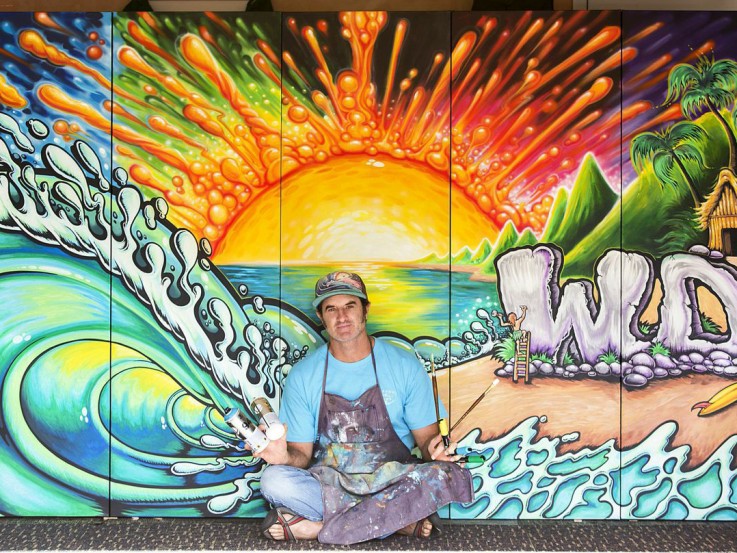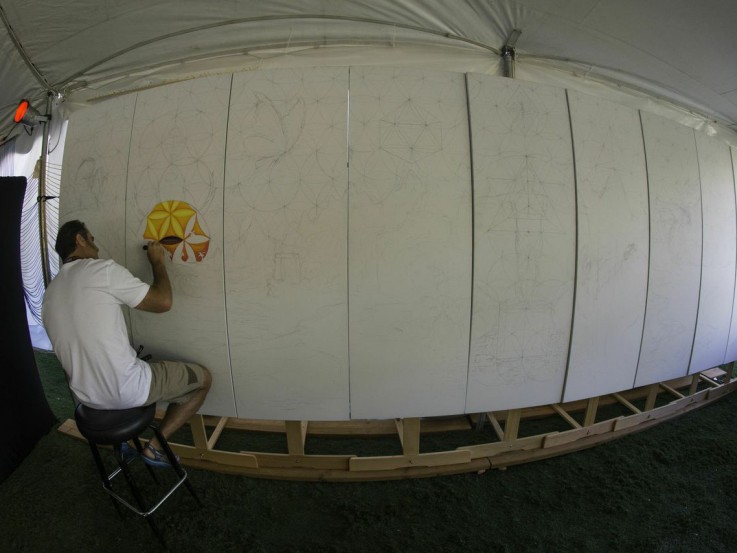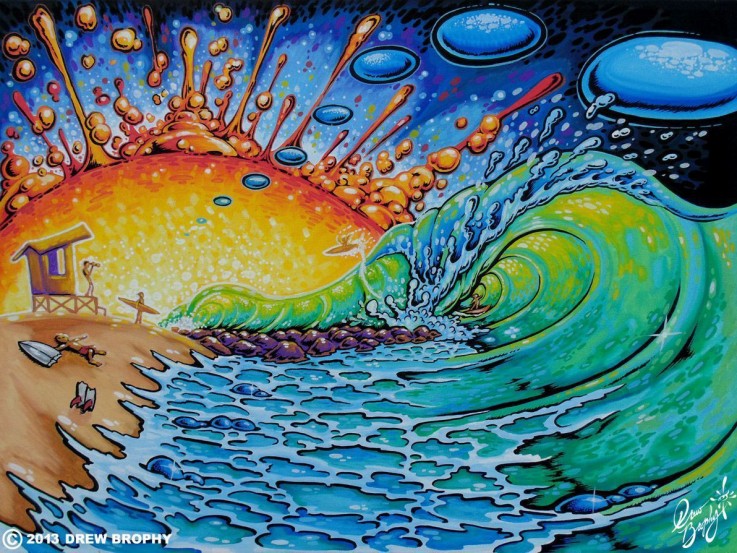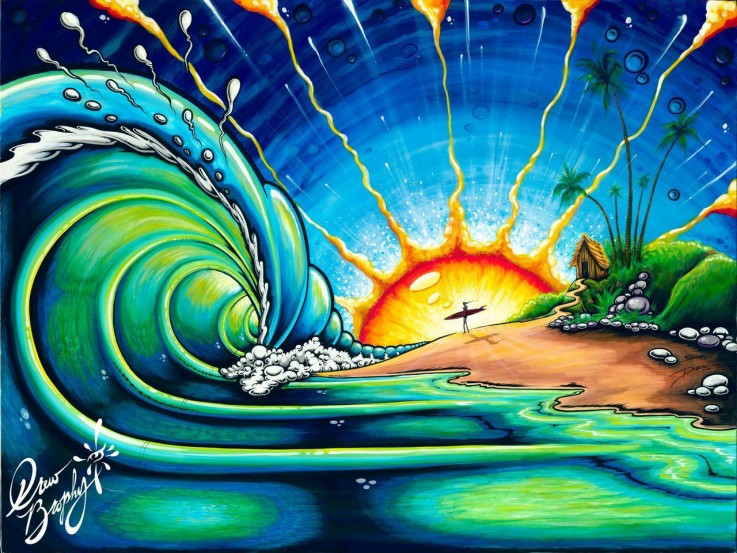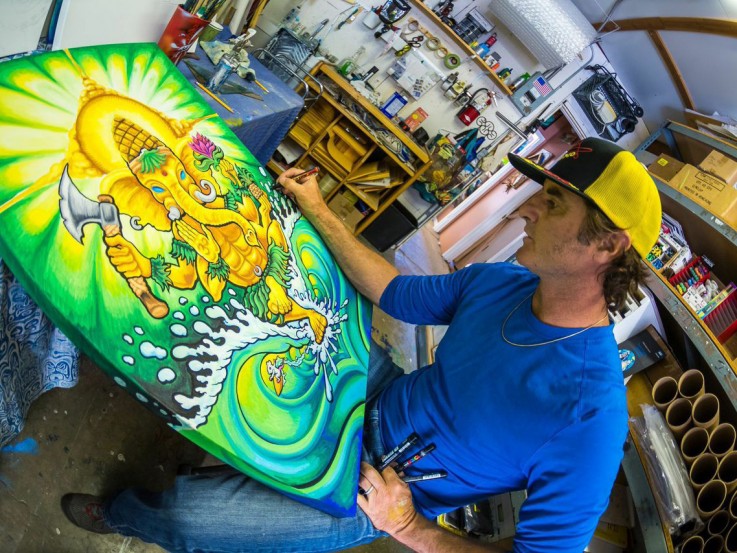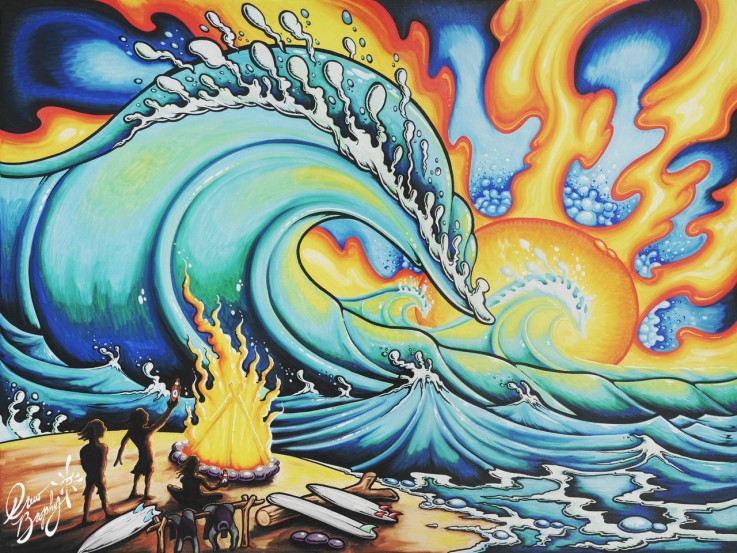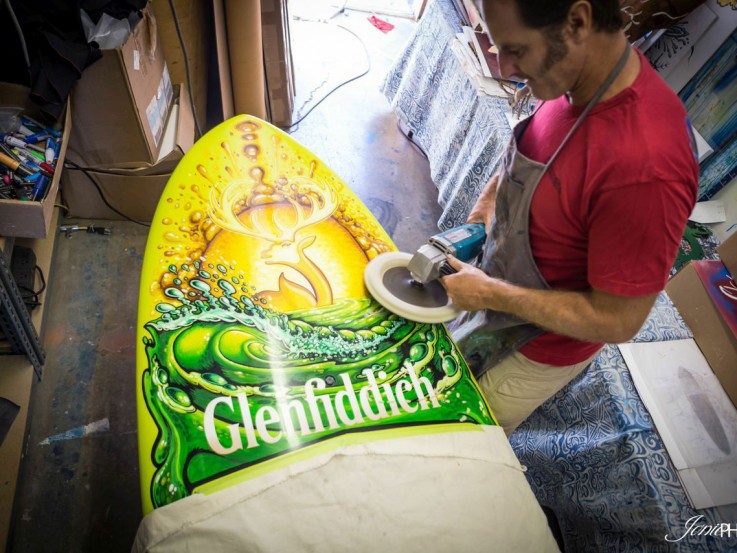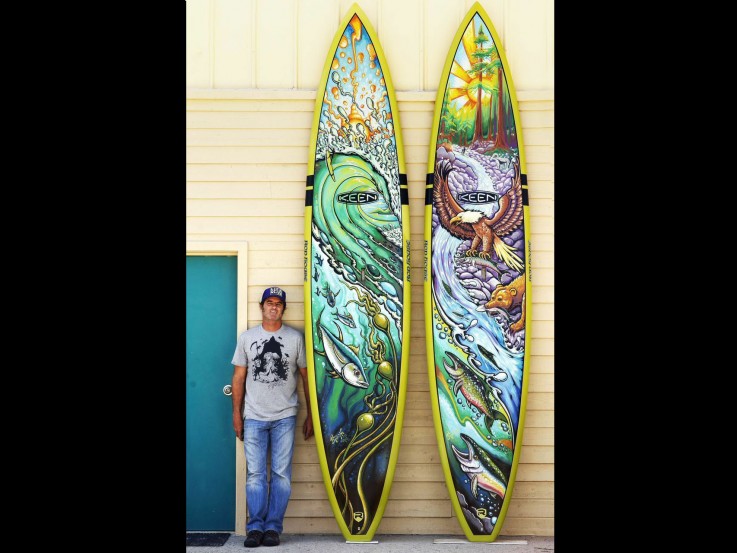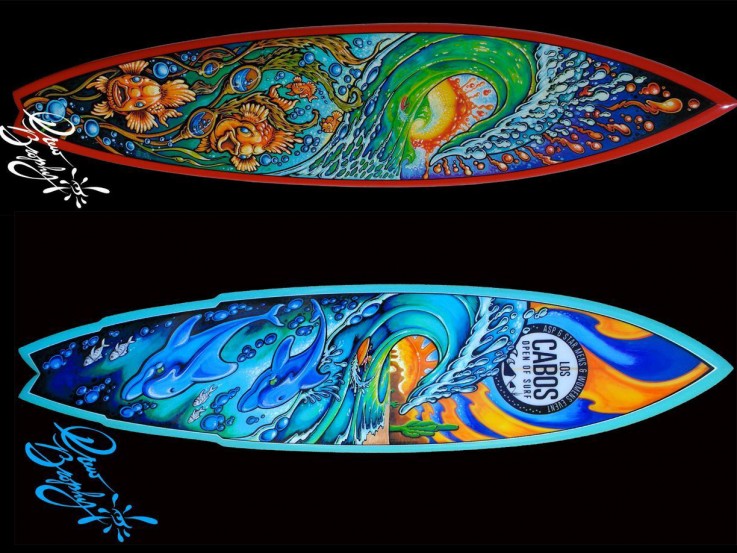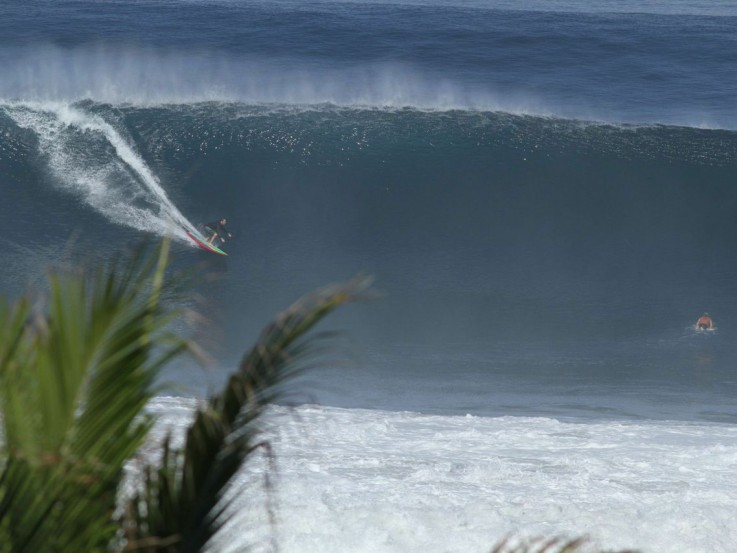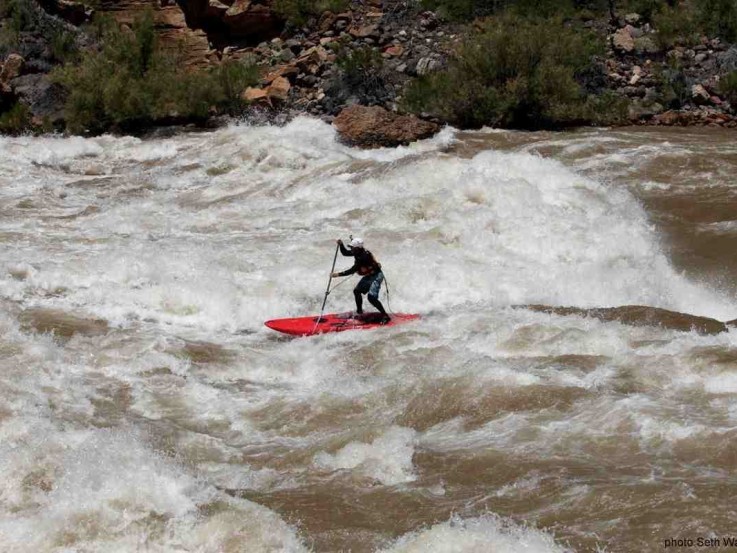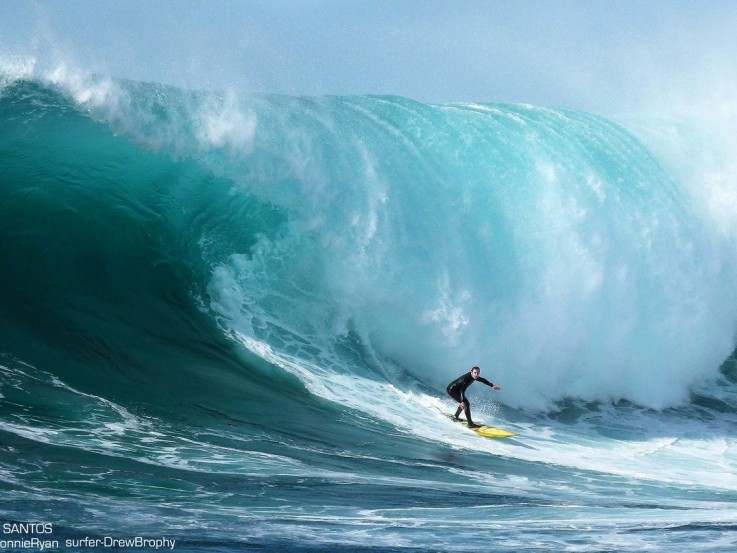Drew Brophy - Artist
When did you start surfing?
I was about four or five years old.
What is it that you love about surfing?
It’s just me and nature, and the energy of the earth.
Do you have a session that stands out as your most memorable?
Hard to choose. I’ve surfed all of the best waves in the world, I have great memories of all of them.
When did you first get into art and did you always want to pursue it as a career?
I used to draw on the walls when I was a child. I drew on everything. I just did what I did best. Surfing and art were my passions, and that’s where I put my focus.
How did you find your niche in surfboard art?
I love to surf, and I always painted my own surfboards. People started asking me to paint theirs. In the late 80’s, I was painting my own surfboards using techniques with Uni Posca Paint Pens that no one else was doing or cared about at the time. I developed my own style of painting with Poscas, and I knew it was the better way to paint surfboards. It took years before others caught on. I never gave up on my vision, though it did not come easy. Early on, I painted production boards, traditional airbrush style, for H2O glassing and Kelly Richards’ Perfection Surfboards, in Myrtle Beach, SC.
Then I moved to Hawaii, airbrushing surfboards at Bill Barnfield’s Pro Glass in Haleiwa on the North Shore for the best surfers and shapers in the world. Brands like Channel Islands, Rusty and Brewer and surfers like Tom Curren and Tom Carroll. This was a big jump for me, coming from South Carolina. I was in the thick of the industry, and I was in my early 20’s.
But, what I really wanted to do was paint surfboards using my own style and paint pen techniques, but none of the companies would let me. The local underground chargers on the North Shore wanted it, but the companies held it back. While in Hawaii, I had approached all the best surfboard companies, asking if I could paint their boards using Poscas. No one would let me, my art was too radical. I was turned down by T & C, Local Motion, all the big companies at that time. Nobody cared about what I was doing.
Eventually I moved to California, painting at Ron House’s Surf Glass in San Juan Capistrano. There, Stewart, Hobie and Harbour surfboards, among others, were being made. At that time, it was the busiest surfboard factory in the world; it ran 24 hours a day. For a surfboard painter, this was a dream job. There was always plenty of work. But I still wanted to paint using my own style, so I continued to seek out other surfboard companies to let me paint my way. I approached Spyder Surfboards, one of the biggest brands at the time, and just like the companies in Hawaii, they didn’t get what I wanted to do and told me “no”.
One day, on my bike ride home from Surf Glass, I stopped to meet artist Matt Biolos, an edgy, up and coming surfboard shaper. We were the same age, and his art was really cool. He was the only person I had seen who was painting with the Poscas, the same as me. He made surfboards for all the young guys. My art was a perfect match for the vibe of …Lost Surfboards at the time. Matt got it! I started painting …Lost surfboards that day. Matt would let me paint whatever I wanted. I would paint ten boards traditional style at Surf Glass, and then at the end of the day I’d go to …Lost where Matt would have surfboards waiting for me, and I’d paint them in my own style.They were an instant hit with the new breed of surfers. Within six months, my art and …Lost Surfboards began to take over the surf market. That was 1996. And the rest is history. Surfboards were changed forever.
Do you recall when your pieces first started receiving widespread response?
Yes, it was in the late 1990’s, when I started painting, live, at the surf trade shows. …Lost would exhibit at Surf Expo and other shows. The surfboards were never finished in time before the show for me to paint them. So my solution was for me to paint, live, at the shows. What surprised me was the massive response.
What I didn’t realize was how engaging the act of live painting was. People were mesmerized watching a surfboard painting come to life. That became the activity in the …Lost booth. The first show, we painted 10 boards during the show. Five years later, I was painting dozens of surfboards over a 3 day show! Buyers were stoked to be able to tell me, on the spot, what they wanted me to paint. It was a spectacle for them to watch it unfold before their eyes.
That’s when I really felt good about what I was doing. At the time, no surfboard makers were selling boards at the show; they mostly took orders for boards. We sold boards AT the shows. People were dumbfounded; every surfboard painting was different. Every single surfboard sold at every show.
What does an average day for Drew Brophy involve?
I stopped painting production surfboards in 2001, and changed my focus to expanding and growing as an artist. Now my year gets booked out by projects. Every day and every week is different. Now my clients are companies like Western Digital, Google, Verizon, and Keen Footwear. This week I’m working on three projects; I’m designing and painting a fine-art surfboard live at a private event at the Hyatt in Huntington Beach, I’m designing the artwork and branding for a new wake park; and I’m finishing up an advertising project with Glenfiddich Scotch Whiskey.
I also have a few commissioned paintings I’m working on for private collectors.
If the waves are good, I surf and work at night. I try to get in the water every single day. And when the waves get big, I’ll travel to wherever they are.
I recently read that you once standup paddle-boarded 225 miles of the Colorado River. Looking back now, what was it like experiencing that part of the world in a way that had not been done before?
It was the trip of a lifetime. Once you put in at Lee’s Ferry, there’s no turning back, there’s no way out. It took 16 days in the wilderness. It reminded me of what my remote surf trips are like; being at one with nature, away from all the bullshit. I’d love to do it again.
A lot of celebrities and well known people collect pieces of your work, have there ever been any that have taken you by surprise or left you a little star struck?
The rock stars and the pretty people don’t impress me. They don’t surf. My role models were shapers, craftsmen and surfers. One memory of being star struck was around 2002, when I had my own booth at Surf Expo. Mark Richards, five time world champ from Australia, came into my booth and asked me to sign a poster for him. I was shocked, and stoked, because he was my favorite surfer growing up. I had never met him before, and here he walked into my booth and asked for my signature!
He invited me to come paint surfboards in Australia. A few years later, my family and I toured Australia, painted his boards and spent time with his family. The best part was surfing Mark Richards’ local spot in Newcastle with him and his son.
What is it that you love about your job?
The freedom to create my life exactly the way I want it.
Do you have any advice for any aspiring surf artists?
My high school guidance counselor was worried about me, and said “Drew, you can’t just surf and paint your whole life.” She was wrong.
Don’t ever let anyone tell you that your ideas are no good. I always knew my style of painting worked better and was more creative. It took a long time for other people to get it, but I never gave up. No matter what you do, someone’s going to love it, and someone’s going to hate it. Find the people who love it.
Where can we find you online?
| Web: | drewbrophy.com |
| Facebook: | www.facebook.com/DrewBrophyArt |
| Instagram: | instagram.com/drewbrophy |
| Twitter: | twitter.com/DrewBrophy |
| Google+: | plus.google.com/+DrewBrophyArt |
| Youtube: | www.youtube.com/user/drewbrophy |
| Pinterest: | www.pinterest.com/drewbrophy |
Posted by: Matthew Ryan, on September 21, 2014
Categories: Interviews
Latest Posts
Craig Sims - White Horses & Surfing Life Publisher
Luke Kennedy - Editor of Tracks Magazine
Simon ‘Swilly’ Williams - Surf Photographer
Jarra Campbell - the Bondi Alchemist
Greg Gordon - Owner of CR Surf
Shayne Nienaber - Surf Photographer
Alexa Hohenberg - Owner of Still Stoked
Christine Deveney - TapaReef Owner & Creator
Russell Ord - Surf Photographer
Richard Kotch - Surf Photographer
Categories
Interviews
Articles
Videos
Press Releases
Quiz
Archive
December 2018
November 2018
October 2018
September 2018
August 2018
July 2018
June 2018
May 2018
April 2018
March 2018
February 2018
January 2018
November 2017
January 2017
December 2016
November 2016
October 2016
September 2016
August 2016
July 2016
June 2016
May 2016
April 2016
March 2016
February 2016
January 2016
December 2015
November 2015
October 2015
September 2015
August 2015
July 2015
June 2015
May 2015
April 2015
March 2015
February 2015
January 2015
December 2014
November 2014
October 2014
September 2014
August 2014
July 2014
June 2014
May 2014
April 2014
March 2014
February 2014
January 2014
December 2013
November 2013
October 2013
September 2013
August 2013
July 2013
June 2013
May 2013
April 2013
March 2013

